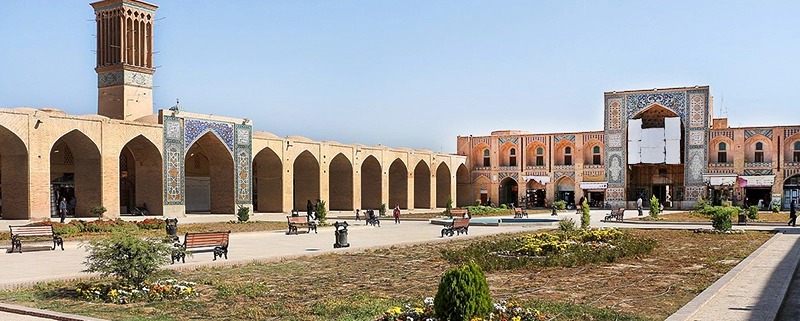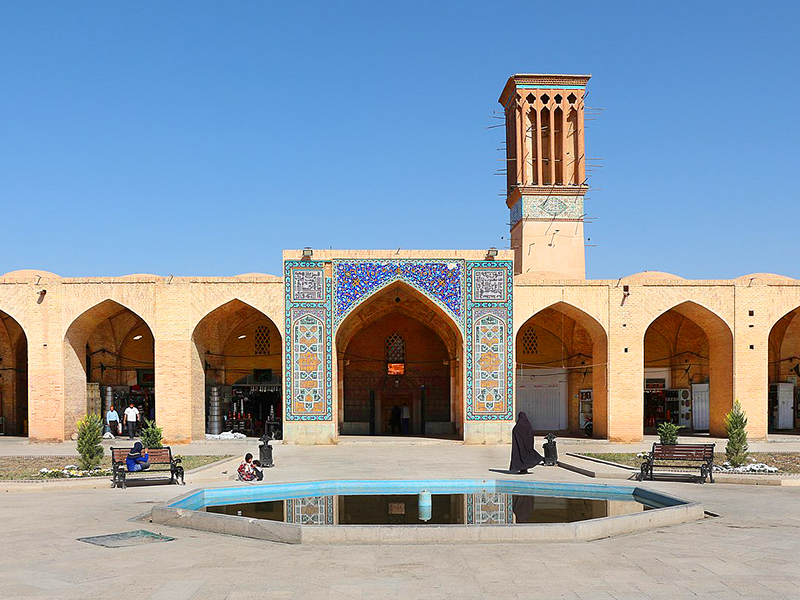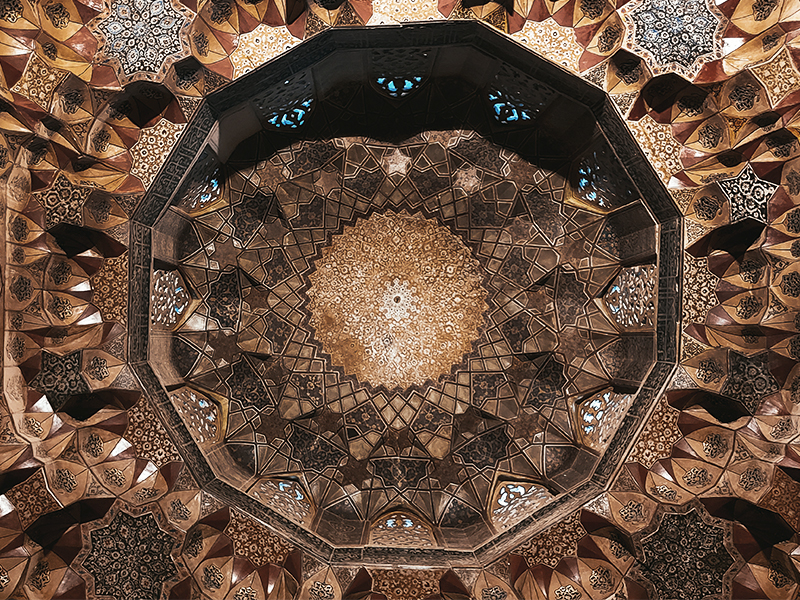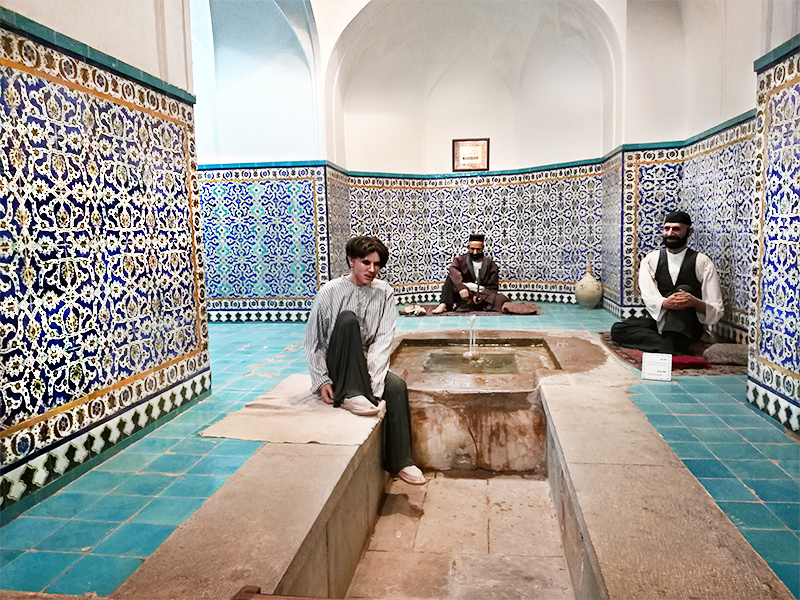Ganjali Khan Complex, Kerman (Photos, History, Address)
Rayen Canyon, Shahdad Desert, and Lut Desert are among the area’s natural beauties. The kind hospitality of the people of Kerman is among its most alluring features. The people here are renowned for their generosity and friendliness, and they take great delight in introducing guests to their customs and culture. This article will teach about the Ganjali Khan Complex, a beautiful location that highlights Kerman’s rich cultural heritage.
Ganjali Khan Complex Iran
A notable historical building that exemplifies the architectural beauty of the Safavid era is the Ganjali Khan Complex in Kerman, Iran. Constructed in the 17th century by the formidable Ganjali Khan, the complex consists of multiple buildings with immense cultural and historical importance. The central square is a bustling hub encircled by arcades, stores, and cafes.
With its elaborate tile work and domed ceilings, the Ganjali Khan Bathhouse provides an insight into traditional bathing customs. The complex’s mosque has a serene courtyard and exquisite architectural embellishments.
The caravanserai, which once housed travelers as rest stops, is now known for its exquisite courtyards and archways. The bazaar is a bustling tangle of stores selling regional goods and traditional handicrafts. A fascinating site where guests can discover the architectural magnificence and fully engage with the lively local culture, the Ganjali Khan Complex is a monument to Kerman’s rich past.
Ganjali Khan Complex in Kerman
Conveniently situated in Kerman, Iran’s city center, the Ganjali Khan Complex is adjacent to several lodging options and dining establishments. Several adjacent hotels are available to visitors visiting the complex, each with a different price range and style. Popular choices in the area are the Pars Hotel, Akhavan Hotel, and Akhavan Hotel Traditional Residence.
In terms of dining, the neighborhood is home to a large number of cafés and restaurants that provide a wide variety of Iranian and international cuisine. Among the well-known eateries in the area are the Kerman Ganjali Khan Restaurant, Shater Abbas Restaurant, and Kerman Traditional Restaurant.
When looking for lodging or a place to eat, the Ganjali Khan Complex’s central location makes it easy to go to hotels and eateries, making it a convenient and pleasurable experience for guests.
GanjaliKhan Mosque
Built during the Safavid era, the Ganjali Khan Mosque is a majestic place of worship situated within the Ganjali Khan Complex in Kerman, Iran. Its courtyard’s rich plants create a calming atmosphere, and the entry portal features exquisite calligraphy and tile work. The prayer hall’s interior is decorated with ornate plasterwork, exquisite arches, and a gorgeously crafted mihrab.
The mosque is a historical and cultural gem that exemplifies Kerman’s magnificent architecture. When combined with other buildings like the bazaar, caravanserai, and Ganjali Khan Bathhouse, it provides guests with a thorough understanding of the city’s rich history. With its spiritual and cultural significance, the Ganjali Khan Mosque is a noteworthy location for anybody interested in Islamic art and architecture.
Ganjali Khan Complex History
The history of the Ganjali Khan Complex dates back to the 17th century. Renowned governor Ganjali Khan ordered it built, and it functioned as a hub for public meetings, trade, and government. The complex’s prominence and profitability were facilitated by its advantageous location along the Silk Road. It is made up of several interconnected buildings, such as the Ganjali Khan Bathhouse, mosque, caravanserai, and bazaar, all of which are designed with magnificent architectural skills.
The complex underwent repair work overtime to maintain its architectural integrity. It was designated as a national historic site in 1972. The Ganjali Khan Complex is a living reminder of Kerman’s rich past and stunning architectural design. It draws tourists from all over the world who come to appreciate the legacy of the Safavid era and Ganjali Khan, as well as to learn about its cultural value.
Ganjali Khan Complex Architecture
The Ganjali Khan Complex in Kerman, with its architecture, is a prime example of Safavid creative excellence. The complex combines Islamic and Persian architectural forms, showcasing exquisite calligraphy, delicate plasterwork, and intricate tilework. The intricate tile mosaic and decorations on the mosque’s entrance gateway make it stand out.
The Ganjali Khan Bathhouse has ornate tiles, arched ceilings, and domed chambers. The elaborate stone sculptures and opulent arches of the caravanserai are striking. The complex’s architectural features facilitate movement and create a lively atmosphere by skillfully fusing usefulness and aesthetics.
The architectural design of the Ganjali Khan Complex is evidence of the vision and proficiency of Safavid artisans and architects. Its beauty and historical significance fascinate visitors, making it a compelling example of Persian-Islamic architecture.
Ganjali Khan Complex Facts
The Ganjali Khan Complex is a masterpiece of Safavid-era architecture, known for its intricate tile work, delicate plasterwork, and beautiful calligraphy.
The facility had several uses. In addition to being a place of worship, it also had a caravanserai, a mint, a bazaar, and a hammam.
Within the compound is the Ganjali Khan Bathhouse, which is still in use and gives guests the chance to partake in a customary Iranian bathing procedure.
During the Safavid era, the complex was constructed by Ganjali Khan, a prominent administrator of the area, and it had a major impact on trade, social life, and governance.
The complex has a modern water supply system that includes subterranean tubes called qanats, which serve as a dependable water source for the baths and other buildings.
In addition to being a historical location, the Ganjali Khan Complex is a thriving cultural center that regularly hosts performances, exhibitions, and other events honoring the artistic and cultural legacy of the area.
The complex is a component of Kerman’s historic city fabric, which is recognized for its cultural and historical significance by being listed on the UNESCO World Heritage Tentative List.
Ganjali Khan Complex Address
Kerman, Iran, is the location of the Ganjali Khan Complex. The complex is located precisely at Ganjali Khan Square in Kerman. There are multiple ways for you to go to the Ganjali Khan Complex. If you are traveling from a different nation or city, you can fly into Kerman’s Shahid Bahonar Airport and then take a cab or make private transportation arrangements to the complex.
You can drive to Ganjali Khan Square in the city center if you have access to a car. You can locate a bus that travels to the complex using Kerman’s local transport system. In addition, ride-hailing services and taxis are offered. The Ganjali Khan Complex entrance fee is also very economical (location on map)
Final Words
The intriguing Ganjali Khan Complex highlights both the rich Iranian culture and the city of Kerman. One of the most exquisite examples of Persian Islamic architecture is the complex. Kerman is a city with a diverse range of attractions, including serene gardens, natural wonders, historical marvels, and a rich cultural legacy. Whether you are taking in its stunning scenery, discovering its historic ruins, or just soaking up the friendliness of its people, Kerman is bound to have an enduring effect on your heart.
Are you planning to travel to Iran & look for an Iran travel agency? Check out our Iran tours. Here’s a free Kerman Virtual Tour for you!









Leave a Reply
Want to join the discussion?Feel free to contribute!